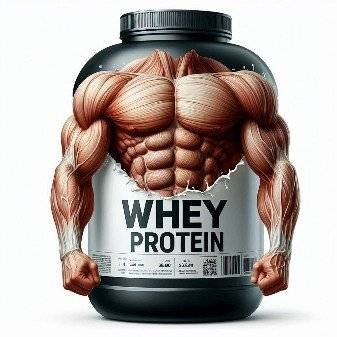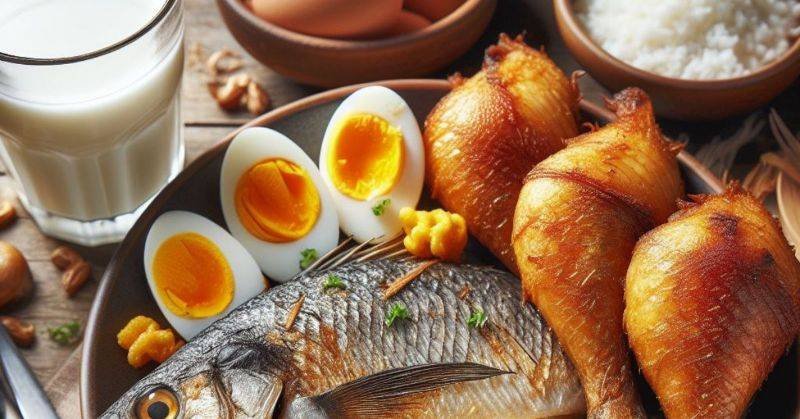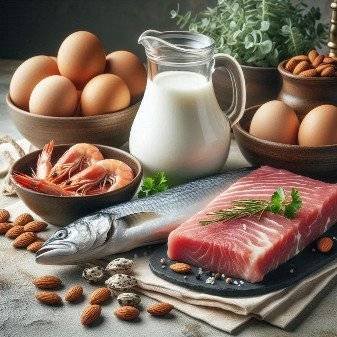
Table of Contents
Proteins are very important macromolecules composed of long-chain amino acids. They are also called macronutrients because they are needed in significant quantities for critical roles in almost every biological process in your body such as:
- Production of enzymes,
- Production of antibodies for immunity,
- Repair of body tissues,
- Muscle or bodybuilding,
- Production of hormones,
- Transportation of materials like oxygen by hemoglobin,
- The formation of the structural components of cells, etc.
Broadly speaking, two types of amino acids make up proteins. These are:
Non-essential amino acids: Your body can synthesize these by itself.
Essential amino acids: These cannot be synthesized by your body so they must be obtained from daily dietary sources. Therefore a key objection in human nutrition is to consume adequate amounts of essential amino acids from dietary sources and they are 9 in number as listed in a subtopic on the source of complete proteins for vegetarians. They are mostly found in animal-based protein sources but can also be found in some plant-based sources.
The amino acids’ arrangement in proteins determines their shape and function. Proteins are known to be the most structurally complex and functionally sophisticated molecules as documented in the National Library of Medicine (NLM)1. Based on their molecular shapes, proteins can be classified into Fibrous(insoluble) and Globular(soluble) proteins.
- Fibrous proteins: Here, the polypeptide chains run parallel to each other and are held together by hydrogen and disulfide bonds. By this, a fiber-like structure is formed making them insoluble in water. Examples are Myosins, collagens, resilin, elastins, and Keratin.
- Globular proteins: when the polypeptide chains coil around each other to give spherical shapes they form water-soluble globular proteins. Examples are hemoglobin, amylase, immunoglobulins, albumin, and insulin.
A polypeptide is a linear chain of amino acid residue and a protein has to contain at least one long polypeptide to be considered as protein.2 Consequently, short polypeptides with less than 20-30 amino acid residues are seldom called proteins but peptides. Furthermore, there are up to 5 levels of protein structure which are:
- Primary,
- Secondary,
- Tertiary,
- Quaternary. And
- Quinary structure.
However, we’ll not go into the details of these structures because they are beyond the scope of this article.
Kindly keep in touch by signing up for our newsletter:
Types of Protein
Types of protein as a topic can vary widely and be addressed based on different criteria with each giving its unique classification of protein types. We’ll delve into this area of discussion based on 3 criteria namely synthesis, source, and function.
Synthesis.
Most types of amino acids that combine to make up protein can and are synthesized in your body as described earlier in this article, however, some can’t be synthesized and must come from dietary sources. This phenomenon forms the first criterion that distinguishes proteins into complete and incomplete proteins.
- Complete Proteins: These have all the 9 amino acids your body can’t synthesize and are mostly obtained from animal food sources e.g. meat and fish.
- Incomplete proteins: They lack the amino acids your body can’t synthesize and are therefore regarded to be incomplete proteins. They are usually from plant-based sources but combining a wide variety of plant protein sources usually makes for completeness. This is important for people who prefer vegetarian or vegan diets.
Source.
Broadly speaking, dietary proteins can only be from animal or plant-based sources. Each plays a unique role in meeting your body’s daily protein need for various physiological processes involving proteins. Being proteins means there are great similarities between the two types of proteins.
Nevertheless, there are clear differences between proteins of animal and plant-based origins as listed in a table on a previous topic where I made a 12-point comparison between animal and plant-based proteins. I’ll elaborate more on both types of proteins later in this article.
Function.
Proteins can also be distinguished based on the roles they play in your body. Each of these roles is vital to health, vitality, and normal bodily functions. These are:
- Enzymes: These set of proteins catalyze biochemical reactions in your body thereby speeding up biological processes like digestion and metabolism e.g. ligases, amylase, transferases, proteases, hydrolases, etc.
- Structural proteins: They are the proteins responsible for providing support and shape to your body’s cells and tissues. e.g Myosin(in muscles), collagens(in skin and connective tissues), and keratin( in hairs and nails)
- Transport proteins: Proteins in this class are biologically designated to carry substances from one part of the body to others or the movement of molecules in and out of cells. e.g. hemoglobin, sodium-potassium pump, voltage-gated sodium or potassium channels, and glucose transport channels(GLUT4).
- Hormonal proteins: They are messengers that help to regulate, activate, or inhibit various physiological processes in the body e.g. insulin, calcitonin, secretin, thyroid stimulating hormone, and luteinizing hormone.
- Defensive proteins or antibodies: They form part of your immune system that helps to fight off infections or immune-related reactions e.g. antibodies, antiviral proteins, and lectins.
- Contractile proteins: These are proteins involved in muscle contraction and movements e.g. myosin and actin.
- Receptor proteins: They receive and transmit signals to cells and are located inside a cell or on its surface. e.g. nerve cell receptors, integrins, and selectins.
- Storage proteins: These are proteins that store essential nutrients in your body e.g. Ferritin is a storage protein that stores iron.

The importance of protein.
Proteins are so vital that you can be sure without them no one will be alive. This is owing to the fact they are critically important in most physiological processes that maintain life. They are actively involved in human nutrition by spearheading the enzymatic breakdown of ingested food particles for the release of nutrients.
They provide the means by which your body keeps you in good health detecting and fighting off infectious bacteria or germs. This is in addition to regulating biological processes that influence your growth, mood, reproduction, etc.
The integrity and shape of body cells including the inflow or outflow of biological molecules from these cells are controlled by proteins. This is in addition to supporting cellular respiration by making oxygen from the lungs available to these cells. Thus they play vital roles in keeping every cell in your body alive and by extension your whole body.
Proteins form the muscles that with your skeletons give shape to your body and enable movement. without them, you will literally be like a mass of immovable matter. In summary, of all the 3 macro-nutrients you get from foods, it can be argued proteins are the most important, contributing immeasurably to the existence of life.
Protein benefits
While there is a limit to how much protein your body can utilize at any given time, there is no limit to how much it can absorb after a meal, contrary to some opinion.
The ingested proteins are vital to the regulation and initiation of a whole lot of physiological processes in your body as stated in the earlier sections of this article. These are seen in the biological actions of hormones and enzymes, for instance. They are also vital to your body’s immunity as antibodies.
As enablers of nerve conduction as nerve cell receptors, they are vital to movement via muscular contraction and relaxation as much as they are the building blocks of those muscles as well. Even the cells in your body derive their shapes from proteins.
That oxygen could get from your lungs to other organs and cells in your body is as a result of transport proteins called hemoglobins. Other transport proteins control or regulate the entry and exit of ions and other substances from your body cells.
Without dietary proteins, there can’t be muscle growth and repair. Even in old age, adequate protein intake which helps in the maintenance of muscle mass is a remedy for sarcopenia, and taking proteins before bedtime may be key to deriving many of these benefits including weight loss.

Protein sources
Proteins are crucial to health and nutrition as has been emphasized in this article. They are the building blocks of most organs and systems in your body. There are two primary sources of these proteins. No matter the form they are presented whether as protein shakes or bars they are derived from these two primary sources.
You may either get them from plants or animal sources as mentioned earlier in this article and understanding the diverse sources can help you to better meet your nutritional requirements.
Plant-based protein sources
Plants present some of the cheapest sources of proteins for humans and animals alike though most of them like maize are low in their actual protein content. While most sources of plant-based proteins don’t have the complete amino acid profile some do and they present a reliable source of this important macronutrient for vegetarians and vegans.

Animal protein sources
Animal-based protein sources have the complete amino acid profile therefore are said to be complete proteins. Being complete proteins means they contain the 9 amino acids your body can’t synthesize on its own and must be gotten from dietary sources.
They are also high in protein content compared to plant-based sources and with higher bioavailability. However, some of them, like eggs, contain proteins that trigger allergic reactions in people. These reactions can prove severe or fatal in rare cases.
Cow milk proteins are some of the most important and available animal-based sources of protein despite their potential for triggering allergies. Whey and Casein proteins are two important proteins derived from animal milk and are often used separately in many foods containing milk. This is due to the individual unique characteristics that set them apart which we highlighted with a table in a previous article.
Best protein sources
What qualifies as the best protein source is entirely subjective as stated in a previous article you may want to read. There are reasons why what may be the best source of protein for you may not be for another which may include health status.
For instance, someone with heart disease or at risk of it may need more plant-based sources than animal ones except certain fish or seafood with heart-friendly healthy oils. Lifestyle choices and personal values are part of the considerations for determining what the best source of protein should be for an individual.
On a general note plant or animal-based proteins, with regards to their unique differences, are on the two ends of the spectrum from which consumers must make their choice. Someone with chronic constipation, for instance, will require more plant-based protein sources with rich fiber content than animal-based ones that are poor in fiber. This also applies to vegetarians and vegans.
Nevertheless, diversifying protein sources through the combination of plant and animal-based origins is very important. This is vital in meeting your daily protein requirement and achieving a balanced diet in which you have all the essential amino acids your body needs.
High protein foods.

Daily protein requirement varies according to age, level of activity, body weight, and body build, among several other factors. For some people, it may be about 50g of protein daily while for others it may be well over 100g. Incorporating high-protein foods into your diet makes it possible to meet your daily protein requirement no matter how high that demand is.
Most animal-based sources of protein are high in the macro-nutrient. For people who take them, meeting their daily protein requirement is a lot easier without hassles. They have a wide range of animal products to choose from most of whom are not only high in protein but are also complete with the full protein profile.
This isn’t as easy for vegetarians or vegans as they have to do more to meet their daily protein requirement. Most plant-based sources are not only low in their protein content but are often incomplete. By this, they lack the full amino acid profile as the essential ones your body can’t produce are missing.
However, some vegetables are very high in protein content and also have the full amino acid profile. Some of them, like soybeans and other soy products, contain more proteins per serving than some animal-based sources.
Be that as it may, it’s only healthy for you to consume proteins within certain limits. That said, there is a minimum and maximum daily protein requirement for everybody. There are serious consequences and health implications in taking more proteins above your daily maximum intake.
How much protein per day?
Meeting your daily protein intake is crucial for supporting various bodily functions, muscle synthesis, metabolism, and general health. The minimum daily requirement of protein to meet these basic nutritional demands based on body weight is given to be 0.8g/kg/day whereas the maximum is daily intake is given to be 3.5g/kg/day.
Based on daily caloric requirements, it is recommended that 10-35% of our daily calorie needs should come from proteins. This is in line with determining protein requirement based on level of activity because the more active you are the more calories you’ll need and by extension the more proteins, however, there is an advantage in weighing your protein need by your age. Generally, older people need more proteins daily to meet the demands of combating diseases and preventing loss of skeletal muscles in a process described as sarcopenia as published in the Journal of Advances in Nutrition.3
For obvious reasons, women’s daily protein requirement is further complicated by some factors such as pregnancy and lactation. During such times their daily protein requirement increases. This phenomenal increase in protein needs also applies to the protein requirements of the elderly.
Protein for weight loss.
High protein intake has been proven to be effective in weight loss as published in the American Journal of Clinical Nutrition4. There are about 6 major pathways by which proteins help with weight loss. When incorporated as part of a balanced diet, proteins increase feelings of fullness which inadvertently means reduced frequency of hunger and by extension lowers your overall calorie intake in a day.
There is also the thermic effect of food. This is the energy expended during digestion and that for protein is quite higher than those for other macro-nutrients like carbs and fats.
High protein low carb diets are particularly effective for weight loss. The high protein low-carb diet plan for weight loss has side effects though. Another option favored by fitness coaches is the use of chia seeds for weight loss which has been shown to be effective by research.
Proteins from chia seeds follow similar pathways to help you lose weight just as proteins from other sources. This is in addition to the high fiber content of these seeds which also helps you feel fuller for longer even during caloric restriction.
To make your weight loss efforts a success with protein intake, there is a clear guideline on how much protein you should consume daily to lose weight. This amount can be gender specific as there is a separate guideline for how much protein women should be consuming to lose weight.

Protein for weight gain.
The general idea of weight gain is a calorie surplus. While proteins are verified agents of weight loss as discussed in this topic and a couple of previous articles, they are not as reliable as other macronutrients like carbs and fats for weight gain.
Research5 has proven proteins reduce weight gain. Anyone looking to gain weight is better off going after dietary carbs, especially refined carbs which research has proven to be the main drivers of weight gain. Protein supplements are often loaded with carbs which increases their net caloric content. Taking these supplements in sufficient amounts significantly increases your overall caloric intake which may result in caloric surplus leading to weight gain.
Proteins are known for muscle building and building your muscles may only result in overall weight loss. This is because an increase in protein intake is already a recipe for weight loss. Additionally, muscle building while on a high protein intake will require active workouts that see you lose calories and fat mass resulting in a net weight loss while helping with improvement in body composition.
However, there are situations where muscle gain can mean weight gain. This can happen in skinny individuals with less fat and musculature. The ideal protein intake for weight gain in these individuals ranges from 1-1.6g of protein daily per kilogram of their body weight as discussed in a previous topic.
Secondly, activity level plays a key role in determining how much protein you’ll need to consume to gain weight. The more active you are, the more proteins you’ll need to achieve your weight gain objectives. For very active people, you need up to 1.6g/kg/day to build muscles which translates to overall weight gain as discussed in a previous article worth reading.
Protein supplements.
In the realm of bodybuilding and fitness, protein supplements have garnered significant attention for their role in muscle gain and improved body composition. Research published in the National Library of Medicine (NLM)6 shows that strength and power athletes may need protein supplementation to meet their daily protein requirements.
Among the most popular forms of protein supplements are protein powders, shakes, and bars. Each of these offers unique benefits but also has its drawbacks.
These supplements often come with added sugars and calories that may disrupt caloric restriction goals. Therefore, it’s important to carefully evaluate their ingredients label with your overall fitness goals, be it muscle mass development or post-workout recovery
It’s important to understand the various types concerning complete and incomplete proteins and their effects on body metabolism. This can significantly aid in crafting a tailored supplementation strategy that best suits your fitness goals. When combined with balanced diets, protein supplements can undoubtedly enhance the effectiveness of your training regimens.
Protein bars.

Protein bars are popular snack choices for people in need of boosting their protein intake for various reasons such as bodybuilding, weight management, improvement in body composition, and overall nutrition or health. They are typically made either from plant or animal sources or a combination of both and tailored to accommodate everyone according to individual needs and dietary preferences.
There are vegan protein bars specially formulated for people on vegetarian diets. You will also find low-carb, low-calorie, and keto protein bars. You’ll always find what suits you regardless of your dietary preferences and health needs.
When selecting the right protein bars, it is important to pay careful attention to the labels. To select the best protein bars that meet your nutritional goals and dietary choice, you’ll need to consider the protein source, calorie content, and quality of the ingredients.
Generally, protein bars made from whole food ingredients, with lower sugar content and minimal artificial ingredients are healthier. They prevent unnecessary calorie intake and are supportive of your digestive health. There are protein bars specially formulated for weight loss though.
Additionally, considering the balance between protein, carbs, and fats is vital in deciding the best fit for you. The time of consumption is one more important aspect of getting the best out of protein supplementation. While some may take it pre or post-workout, having it as a pre-bed protein snack may come with added benefits in line with your health and nutritional objectives.
Protein shakes.
Protein shakes are another popular means of increasing your protein intake via supplementation and can be taken anytime including as a pre-bed protein shake. They owe their popularity to their simplicity, and convenience, and may be prepared using water or milk with each having its distinct characteristic. The milk may be animal-based (dairy) with its richer protein content as well as complete amino acid profile, or plant-based for those allergic to dairy or milk protein.
The source of milk for plant-based milkshakes, unlike animal-based ones, is more diverse. Almond milk protein shakes are one of the commonest with their rich taste. Another popular choice is the coconut milkshake. You’ll be in a better position to tell if you prefer protein shakes prepared with water or milk by the time you take a look at a table where we list the unique advantages of each type.
You may choose either a commercially made protein shake you buy from a store or a homemade shake. The store-bought protein shake is suitable for those on the go and offers a quick solution for protein supplementation. Nonetheless, they don’t always meet individual caloric and protein profile requirements in addition to the preservatives they come with plus added sugars and sweeteners.
Homemade protein shakes offer some advantages over the commercial ones. Firstly, making it at home gives you control over the choice of ingredients and you exclude preservatives. A basic recipe for a homemade shake could include:
- One scoop of your preferred protein powder,
- One banana,
- A tablespoon of almond butter, and
- A cup of unsweetened almond milk.
Blending these ingredients in addition to any extra additions you may want to add is all it takes to prepare your choice protein shake. However, in the absence of preservatives homemade protein shakes don’t last as long as the store-bought ones. For this reason, you mustn’t store them for long to avoid the undesirable consequences of consuming bad protein shakes.
Protein powder.
Protein powders are made through a meticulous production process with carefully selected plant and animal sources such as whey, casein, bugs, or soybeans. With their popularity among fitness enthusiasts and the general population, they offer a convenient way of supporting muscle gain and overall dietary needs. Most powders come with artificial sweeteners, preservatives, and flavor enhancers.
While animal-based protein powders are often made from whey, casein, or bugs, plant-based powders may come from peas, brown rice, and hemp. Plant-based protein powders usually lack the complete amino acid profile so are incomplete proteins. However, a combination of a wide variety of plant sources yields protein powders with all the essential amino acids.
Most people get just about enough proteins from a normal balanced diet. Protein powders are therefore a common reason some end up taking too much protein. Excess protein consumption can cause constipation but there are protein powders that don’t cause constipation. There are a couple of other symptoms consuming excess protein powders can cause as discussed in a previous article you may want to read.

Best protein powder.
The best protein powder is subjective as it depends on your needs and dietary preferences. Protein powders can be specific to your health and dietary needs, however, there are other factors to consider when selecting the best protein powder for you such as quality, protein profile, and added ingredients.
Two of the most popular protein powders are whey and casein and they contain the complete amino acid profiles. Plant-based protein powders will contain a wider variety of plant sources to have a complete amino acid profile. Whichever one that works best for you, the powder needs to have a high protein content per serving,
Protein powders may not be safe for everyone and there are side effects that may come with their consumption. The commercially available powders will typically last more than anything you can prepare at home but you need to beware of their expiration signs as they eventually expire just as any other food. However, even an expired protein powder can still be useful to you in a couple of ways.
With this article, Healthcrust has covered virtually all essential areas of interest in Proteins. For whatever reason you want to boost your protein intake, we’ve provided all you need to know about what protein sources will suit you and are in line with your health status and dietary preferences.
Also discussed in previous topics are guidelines on how to reliably use proteins for various health, fitness, and nutritional purposes. Questions are welcomed on any subject or areas you feel we haven’t touched or done justice to.
References.
- Alberts B, Johnson A, Lewis J, et al. Molecular Biology of the Cell. 4th edition. New York: Garland Science; 2002. The Shape and Structure of Proteins. Available from: https://www.ncbi.nlm.nih.gov/books/NBK26830/
↩︎ - Wikipedia contributors. (2024, October 19). Protein. In Wikipedia, The Free Encyclopedia. Retrieved 19:35, October 25, 2024, from https://en.wikipedia.org/w/index.php?title=Protein&oldid=1252054200 ↩︎
- Traylor, D. A., Gorissen, S. H. M., & Phillips, S. M. (2018). Perspective: Protein Requirements and Optimal Intakes in Aging: Are We Ready to Recommend More Than the Recommended Daily Allowance? Advances in Nutrition, 9(3), 171-182. https://doi.org/10.1093/advances/nmy003 ↩︎
- Clifton, P. M., Keogh, J. B., & Noakes, M. (2007). Long-term effects of a high-protein weight-loss diet. The American Journal of Clinical Nutrition, 87(1), 23-29. https://doi.org/10.1093/ajcn/87.1.23 ↩︎
- French WW, Dridi S, Shouse SA, Wu H, Hawley A, Lee S-O, Gu X, Baum JI. A High-Protein Diet Reduces Weight Gain, Decreases Food Intake, Decreases Liver Fat Deposition, and Improves Markers of Muscle Metabolism in Obese Zucker Rats. Nutrients. 2017; 9(6):587. https://doi.org/10.3390/nu9060587 ↩︎
- Hoffman JR, Ratamess NA, Kang J, Falvo MJ, Faigenbaum AD. Effects of protein supplementation on muscular performance and resting hormonal changes in college football players. J Sports Sci Med. 2007 Mar 1;6(1):85-92. PMID: 24149229; PMCID: PMC3778704. ↩︎































































































































































Wonderfully detailed blog post.
This website was recommended by my cousin. You are amazing Thanks
I do believe all the ideas you’ve presented in your post will certainly work. They are really convincing. Thanks for the post.